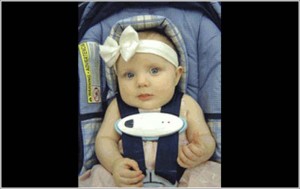
Devices like the Child Minder Smart Pad just aren't effective enough for parents to trust, warns NHTSA.
Sensors designed to warn parents who’ve left children in their car when the vehicle gets too hot aren’t reliable, the U.S. government is warning. That means parents may get a false sense of security when their kids’ health and safety is actually at risk.
The aftermarket devices are difficult to install and prone to deliver false warnings that may encourage parents to ignore a signal when children really are in danger, warned David Strickland, director of the National Highway Traffic Safety Administration.
“While we feel these devices are very well-intended, we don’t think they can be used as the only countermeasure to make sure that you don’t forget your child behind in a car,” the nation’s top automotive safety chief stressed during a conference call with reporters.
The issue is not insignificant. A number of children have reportedly died after being left in vehicles during the recent heat waves that have swept across much of the country. In 2010 there were 49 such fatalities, though the number dropped to 33 last year as attention to the problem increased. Heat stroke is reportedly the leading cause of death for children under 14 after vehicle crash-related incidents.
Complicating the problem with the use of aftermarket sensors, the devices will not warn parents if a child enters the vehicle without their knowledge or if a child is not in an approved child seat. Those situations account for about 40% of the deaths caused by excess vehicle heat.
The devices may also be subject to cellphone interference or the lack of a signal, and are prone to short circuiting if liquid spills on them, a not-uncommon problem in a vehicle used to transport children.
“The devices (tested) required considerable effort from the parent to ensure smooth operation,” said Kristy Arbogast, a researcher with the Children’s Hospital of Philadelphia, which released a study on the technology in conjunction with the NHTSA news conference. “Some of the devices turned on and off or beeped during the drive. We’re concerned about the frustration and source of distraction this might lead to.”
Several manufacturers have discussed the possibility of building child heat sensors directly into a vehicle but have so far not brought the technology to market. It’s not clear if that’s due to technical challenges, costs or other issues.
With the relative ineffectiveness of the technology, Strickland warned parents the devices cannot be effectively trusted and that they should consider finding an alternative means to ensure children are not exposed to dangerous heat by being left inside a car.

As I’ve only seen them tried as rather-small and ineffective aftermarket devices, I’m wondering why we’ve never seen an automaker fit its vehicles with solar collectors embedded in the roof or windows to power exhaust fans that would reduce cabin temperatures when the car is parked. Even if this approach doesn’t prove powerful enough to save the life of a child or pet left in a car on a sweltering day, it would be nice to climb back into your driver’s seat without the upholstery searing you like a skillet – almost inevitable if you like wearing shorts or mini skirts in the summer months!
Actually, I recall several makers offering solar-powered collectors over the last decade or so. I believe Mazda was one and I’m all but certain you can order a Prius with the technology. But, no, it is not commonplace.
Paul A. Eisenstein
Publisher, TheDetroitBureau.com